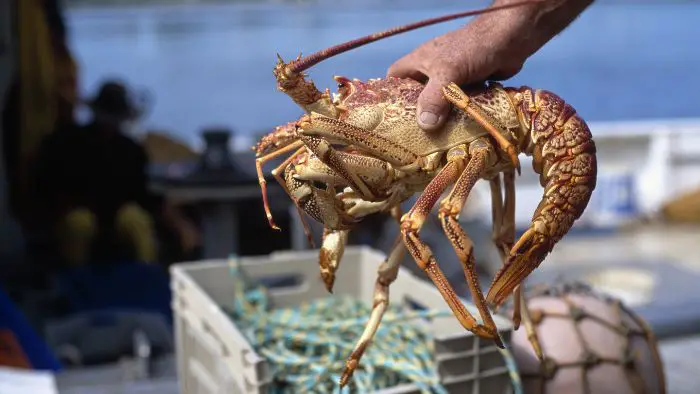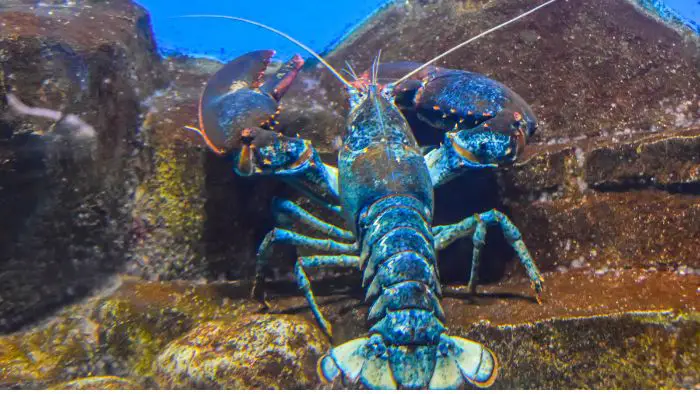Last Updated on September 8, 2024 by Sara Rose
Would you like to know how to raise lobster at home? What you need, what to get, what to avoid, what to watch out for? Keep reading this article to learn all you need to know.
Table of Contents
Lobsters
Lobsters are marine crustaceans belonging to the Nephropidae family. They have characteristic long bodies and muscular tails. They like to live in crevices or burrows at the floor of the sea. This is important to know if you are going to keep lobsters at home, so you can create the ideal living environment for them.
Lobsters are popular as food. Many restaurants provide the pleasure of catching your own lobster from a tank and they cook it for you. You can create the same experience at home.
You can raise lobster at home even as a pet, even if you don’t want to eat it, you will want to provide it with the same great care. Let us get into how you take care of your lobster.

How To Raise Lobster At Home
1. Choosing the right tank size
The first thing you need to consider when it comes to raising lobster is choosing the right tank size. Set up a tank that is large enough to hold twice as much volume of water for the size of the lobster, even more if you expect them to grow.
2. Providing the right water temperature
Because lobsters are a cold water species, you will need to attach a chilling unit to your aquarium or tank. This should help you maintain the water temperature between 40 and 45 degrees Fahrenheit, which is their ideal temperature.
3. Maintaining salinity
Lobsters are marine creatures, therefore the water that you keep them in must have the salinity of seawater. Failing to provide this for your lobster can spell disaster. It may interfere with their osmoregulatory mechanisms, meaning that they may not be able to maintain their salt balance. Use ocean sea salt to get the salinity of your water right. Keep it at 30 to 35 parts per million for the best growth and health of your lobster.

4. pH
Maintain the pH of the water tank between 6.5 and 8.5. You can use water changes or chemicals to adjust the pH accordingly.
5. Keep the tank clean
Perform a water change of 10-15% replacement weekly to keep the lobster tank healthy.
6. Feeding
Only feed your lobsters when they are still young. There are various types of pelleted food that you can purchase from pet stores. Make sure that your filtration system is efficient at cleaning up the water after feeding.
Once your lobsters are grown and have reached adult size, you do not need to feed them. As long as the water is maintained at the right conditions, they can go for months without feeding.
7. Harvesting
If you are growing your lobsters for eating, harvest them when they are fully grown and are no longer showing signs of any growth.
Considerations For Your Lobster Tank Or Aquarium
When you have successfully set up your system and have your lobsters in the water, watch out for foam that may form at the surface of the tank. This could signal a sick, wounded or dying lobster. In this case, you will need to act fast, investigate the issue and deal with it before it becomes too much of a problem.
In the system that you construct for raising your lobster, never use any materials composed of copper, brass, zinc, bronze or lead. These materials are toxic to lobsters and may kill them. Only use stainless steel or PVC piping
Can Lobster Live In Freshwater?
Lobsters are marine animals. Although they can be found in freshwater, keeping them in there for long periods of time will ultimately not be good for them. Use sea salt to adjust the salinity of their water to 30 to 35 parts per million.
Raising Freshwater Lobster
Lobsters are marine or seawater creatures, their closest freshwater relatives are crayfish. So if you would like to raise freshwater “lobster”, crayfish are your go to crustacean.

Freshwater Lobster Aquaponics
Freshwater lobster can be raised in an aquaponics system. You just have to make sure that the requirements of both your lobster and the crops/ plants that you are growing are being fulfilled. That means that the amount of feed you are providing to your lobster must produce enough waste (which translates to nutrients) for efficient growth of the plants. And that the plants are cleaning the water efficiently to provide your lobster with the ideal water quality parameters.
Freshwater Lobster Care
Caring for your freshwater lobster is generally the same as taking care of your marine lobster, except that the water does not have as much salinity.
The important considerations such as water quality parameters, tank size, feeding, and care are the same. You will need to do a bit of research on the species of freshwater lobster that you are keeping to know the specifics such as water quality parameters.
Maintain the ideal environmental conditions and you will have very healthy and happy lobsters to enjoy.

Conclusion – Raise Lobster At Home
Lobsters are very easy, low maintenance animals to keep in an aquarium. As long as you provide them with the right tank size, ideal water quality conditions, and be careful to not overfeed them, they will grow healthy and happy.
Remember that lobsters are solitary in nature. This means that they are territorial and like to have their own space. Be careful not to overcrowd them in a tank or there will be a lot of chaos. If you are raising more than one lobster, give them ample space to be able to establish their own territories and not feel cramped.
Lobsters are also cannibals. If you are going to raise them in a tank that has other, smaller sized fish, prepare to have them eaten. If you don’t want that to happen, it is best to keep them apart.
We hope this article provided you with all you need to know about how to raise lobster at home, and now you will go and do so confidently.
If you enjoyed reading this article and found it useful, please share it with your family and friends.

An aquaculture specialist and freelance writer. Passionate about anything sustainable living, such as growing your own food, and if you can do it in conjunction with fish farming, even better! I currently work as an aquaculture researcher where I can expand and share my knowledge and skills on aquaculture, crop farming and adding value to wastewater by using it to grow food products. I enjoy reading and learning as much as possible, and writing is another avenue for me to share the knowledge I gain with others. I want my writing to inspire people to try their hand at gardening, whether indoors or outdoors. You can even start by keeping a few houseplants indoors to help you gain a bit of confidence if you need to.
